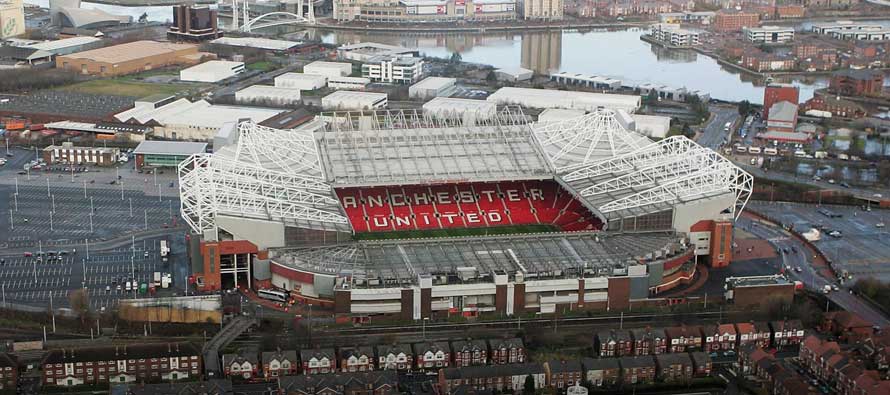If a keen football fan you will already know a great deal about UK football clubs, but what about the stadiums in which the top teams play. To expand your knowledge on the subject here are some of the interesting facts about the top locations for Premier League games.
Old Trafford
A good place to start is the largest stadium in the league, though the Theatre of Dreams has far more to offer than its 75,000 seats. Designed by famous architect Archibald Leitch, the stadium was opened in 1910 and was remarkably – almost ridiculously – grandiose for its day. It was so large it required the construction of its own railway station and earned the home team Manchester United the nickname “Moneybags United”. To put the £60,000 construction budget into perspective, the average transfer fee at that time was just £1,000.
Since then Old Trafford has been renovated several times, including significant reconstruction following bomb damage during the Second World War. The Taylor Report in 1990, which demanded the top stadiums become all-seating, reduced the capacity to 44,000, but the club’s incredible success allowed for a major redevelopment in 2006 that brought it up to its current 75,000.
The roar of all those voices makes the Theatre of Dreams a must-see location on game day, even if you’re not cheering for the team in red.
Anfield
Opened in 1884, Anfield is one of the oldest stadiums in the league and was originally the home ground for Everton – but don’t tell that to the Liverpool fans who have been packing the stands since they took it over in 1892. There are few experiences in the football world that compare with standing among the thousands of fanatical fans and feeling the chills run up your spine as You’ll Never Walk Alone reverberates around the stadium.
Interesting innovations have occurred at Anfield, such as the establishment of the famous Liverpool Boot Room in the 1960s where the coaching staff would meet to drink tea and discuss tactics. Another was the official Match of the Decade in 1996 when Liverpool overcame Newcastle by 4-3 in a truly thrilling game.
In late 2016, the brand new Main Stand was opened, adding an extra 8,500 seats and bringing the capacity up to 54,000. A range of other plans is in the pipeline, including redeveloped changing rooms and a new club shop.
Stadium of Light
The best-named stadium in the league earned its title in tribute to the Sunderland region’s proud industrial and mining heritage. The Davy lamp monument at the entrance further reinforces this point. The Stadium of Light was opened in 1997 after the Black Cats outgrew their home ground at Roker Park, which had been in use since 1897.
The stadium originally had a capacity for 42,000 fans but this was expanded in 2002, bringing it up to the current 49,000 that gives it the sixth-largest capacity in the Premier League. A visit to the Stadium of Light is not complete without a drink at the Black Cats Bar.
The Emirates
You will recall Arsenal’s 2003/04”Invincibles” season referred to in the 888sport blog, but did you know that Ashburton Grove was called the Emirates Stadium after naming rights were given to a sponsor. The ground has a capacity of 60,000 that makes it the second-largest stadium in London. It was opened in 2006 when Arsenal moved from Highbury, a transfer that became necessary after the changes brought about by the Taylor Report reduced that stadium from a capacity of 57,000 to less than 40,000.
Many fans do not like The Emirates as much as Highbury, saying the atmosphere simply didn’t carry across and the matches feel a bit empty. That being said, it cannot be denied the stadium has some of the best facilities in the Premier League and one of the best pitches in Europe.
Stamford Bridge
Many of the football fans that visit Stamford Bridge would be surprised to learn just how old it is. Regular renovations, thanks to the large amounts of money that flow Chelsea’s way, have kept the ground entirely up to date. It was first opened in 1877 to host events by the London Athletic Club and was designed by renowned architect Archibald Leitch, who was also behind the creation of Old Trafford and a number of other great stadiums. It originally had a remarkable official capacity of 100,000 people, but this was reduced in 1905 when Chelsea was formed and took it over as their home ground. Since then, its capacity has fluctuated several times with various upgrades; it currently stands at 41,000.
Stamford Bridge has witnessed many of football’s greatest moments, including the 82,905 fans that packed the stadium to watch Chelsea play Arsenal in 1935. That game, which ended in a 1-1 draw, remains the second-highest attendance for an English top division match. By far the most significant game, though, was when Chelsea took on Soviet Union team Dynamo Moscow in November 1945. The game was planned as a way to ease the Cold War tensions that were gripping Europe and signal to all fans that football was back following the suspension of competitive divisions during the Second World War.
Then there’s the time England beat Norway at Stamford Bridge in September 1066, on their way to the final against the Normans at Hastings, but that’s an entirely different story.

